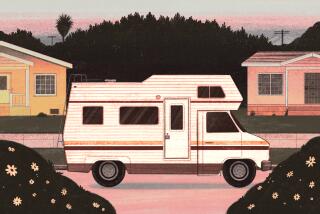RV Sales Ride New Wave of Wanderlust
- Share via
INDIANAPOLIS — With customers like Mary Jo Athman, it’s easier to see why RV makers and sellers see a bright future.
Athman, a 35-year-old office manager from Waite Park, Minn., recently bought a new 25-foot trailer -- and plans to hang on to her old 1960 model.
The new RV will be used mostly for weekend trips to a family cabin in northern Minnesota’s lake country with her husband and their 11-year-old daughter. The old one will provide sleeping space for home guests.
“As far as accessories, the old one has an icebox, if you want to call that an accessory,” Athman said. “The new one has the bathtub, the shower, the refrigerator and the freezer, and it’s got enough beds so that you don’t have to fold out furniture to make your beds.”
With baby boomers’ leisure time expanding and interest rates at historic lows, sales of recreational vehicles are surging. Last year was the best ever, and industry officials see more of the same for 2004.
“I think we’re just kind of riding a pretty good wave of business right now,” said Dave Altman, president of Altman’s Winnebago, a 32-year-old dealership in Baldwin Park. “I don’t see a bubble there.”
As in the 1980s, when RVs had their last big sales boom, today’s optimism is an outgrowth of low interest rates and inflation and higher disposable income that have put RVs within reach of more consumers.
This time, the industry also has demographics on its side as wanderlust-inspired baby boomers respond to a marketing campaign targeting consumers who haven’t yet reached retirement age.
Also driving RV sales are the hassles of air travel and fears of traveling abroad -- both outgrowths of the Sept. 11 terrorist attacks.
Better-equipped vehicles also are a huge draw, including high-end models with satellite dishes, DVD players, washers and dryers and compartments that slide out from parked RVs to create more space. Such features can drive motor home prices as high as $400,000.
In December, the $12-billion-a-year industry’s trade group, the Reston, Va.-based Recreation Vehicle Industry Assn., projected factory-to-dealer deliveries of RVs in 2004 would rise 2.3% above last year’s shipments. Last month, based on surging shipments in late 2003 the association boosted its 2004 forecast to 2.9% growth.
The forecast projects 330,100 RV shipments this year, breaking the record of 321,000 set in 1999 and up from a recent low of 257,000 in 2001. Shipments are on track to post their best six-year period of growth in a quarter century.
“There are a lot of RV companies out there that are going to have a good year,” said Joseph P. Tomczak, executive vice president at Elkhart, Ind.-based Coachmen Industries Inc., a maker of RVs and modular homes.
Coachmen, which employs nearly 4,500 workers, forecast last month that its 2004 sales would rise as much as 12% from last year, with earnings expected to nearly double.
In northern Indiana, sales of RVs and travel trailers have helped offset severe job losses in other segments of heavy manufacturing. Industry figures show about 58% of the nation’s RVs are produced in Indiana. More than 100 different brands of RVs are produced within 25 miles of Elkhart, which bills itself as “RV Capital of the World.”
Amid overall manufacturing job declines, Indiana RV makers like Coachmen, Gulf Stream Coach and Monaco Coach have been hiring workers, with Coachmen adding a new 300-employee plant last year in Middlebury.
Statewide, employment at plants manufacturing RVs, travel trailers and campers grew 26% from 17,200 in January 2002 to 21,700 in December of last year, according to state data.
Since the first RV models appeared in the 1930s, RV sales have typically surged months ahead of recoveries in the national economy, and RV sales declines have preceded recessions, industry officials say.
The industry’s record as an economic bellwether has held up this decade. RV shipments rose 21% in 2002 while the economy as a whole began a slow rebound. Last year, shipments rose another 3.2%.
“I don’t see references to this kind of future opportunity until you go back to coming out of the astronomical interest rates and fuel shortages of the 1970s,” said Al Hesselbart, a historian at an RV museum in Elkhart who writes for industry trade journals.
“I think the growth the industry is projecting the next year or so is every bit as good as what it was in the early 1980s.”
More to Read
Inside the business of entertainment
The Wide Shot brings you news, analysis and insights on everything from streaming wars to production — and what it all means for the future.
You may occasionally receive promotional content from the Los Angeles Times.










